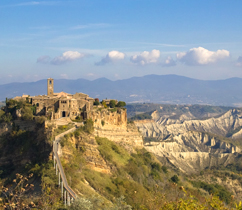Civita di Bagnoregio

The Dying City. This was the name given to Civita di Bagnoregio after our countryman Bonaventure Tecchi, a writer and scholar of German, described it in his famous tale.
The “life” of Civita di Bagnoregio has been a bumpy ride throughout history. After the fall of the Roman Empire the city was taken over by the Goths and then the Lombards. It was subsequently conquered by Charlemagne and donated to the State of the Church. At the end of the fifteenth century the citizens of Bagnorea (the ancient name of the town) managed to drive out the Monaldeschi tyrants and defeat the troops of Charles VIII.

It took another 200 years to partly free themselves from the direct rule of the Pope and become part of the Apostolic Delegation of Viterbo, a body that was far more democratic and liberal, as we would say in the present day.
A first earthquake in 1695 worsened the effects of erosion, causing a partial collapse of the city. A second earthquake in 1794 brought down the narrow natural bridge that connects Civita to the township Rhota. In this period the inhabitants began to settle down in Rhota, a district built in the thirteenth century. The famous “battle of Bagnorea” between the papal troops and Garibaldi’s volunteers was also fought in this city.

The fragile tuffaceous hills on which Civita stands was endangered by the erosion caused by two streams flowing around it.
With the town doomed, the surreal landscape of the Valley of the Calanchi (Badlands), and the tufa cliffs that emerge from the thick vegetation, make Civita di Bagnoregio a unique and fabulous place.
One of the most important monuments of the small town is Porta Santa Maria, which has two lions with human heads at the top; a symbol of the defeat of the ancient tyrants. Facing the main square you can admire the Church of San Donato, which houses a magnificent wooden crucifix of the Donatello school and a valuable fresco of the Perugino school.
Renaissance palaces line a number of charming narrow streets, accompanied by typical stairways with balconies called “profferli”, which are typical of medieval Viterbo buildings.

The only main road that cuts through the Civita reaches a path carved into the stone in Etruscan times, leading to the ancient Quartiere Carceri (Prisons district), which collapsed in the earthquake of 1794; an ancient hole reveals a colourful chestnut grove and breath-taking views.
